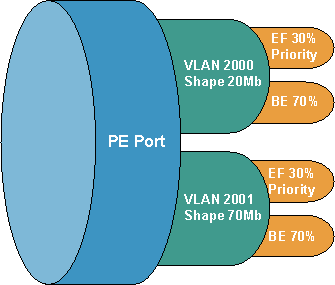Brad Fleming from Kanren gave me remote access to a lab MX5 router in order to do the Junos section of this port for when I am very grateful!
There are many different needs for H-QoS and may different ways to configure it. I’m going to be going over one particular use case for H-QoS in which I use on a daily basis. More so than any other type of QoS, H-QoS is very hardware specific. Even line-card specific. In this post I’ll be using a Juniper MX5 and a Cisco ME3600X, both which allow me to do H-QoS on their gig ports.
My use case is as follows. Core gig ports are not cheap. ‘Revenue ports’ as ISPs like to call them. Most core kit has a load of gig ports, some 10Gb ports and maybe 40Gb/100Gb ports.
Not all customers want 1 gig link. Some want 10Mb, others 50Mb, some 300Mb. Heck some only want 4Mb. In order not to waste precious revenue ports, these circuits are aggregated into a single physical gig port. i.e. we can put 10 X 100Mb circuits onto a single gig link.
The bigggest problem with doing this is that it gets difficult to give QoS outbound back to the customer unless your hardware can do H-QoS. Let’s take the following port diagram as an example:

The physical port is 1Gb. Here I have two customer circuits attached. Customer A is paying for 20Mb while Customer B is paying for 70Mb. Not only do I want to shape their respective queues, I also want to give 30% priority bandwidth to each customer, inside each queue. So I need to shape vlan 2000 to 20Mb, and inside that 20Mb ensure 30% is given to EF packets.
IOS
In IOS I create the child and parent policies.
policy-map 30_70
class EF
priority
police cir percent 30 conform-action transmit exceed-action drop
class class-default
queue-limit percent 100
!
policy-map 20Mb
class class-default
shape average 20000000
service-policy 30_70
!
policy-map 70Mb
class class-default
shape average 70000000
service-policy 30_70
Each policy can then attach to an EVC outbound on a physical port:
ME3600X#sh run int gi0/1
Building configuration...
Current configuration : 674 bytes
!
interface GigabitEthernet0/1
switchport trunk allowed vlan none
switchport mode trunk
mtu 9800
service instance 1 ethernet
description CUSTOMER1
encapsulation dot1q 2000
rewrite ingress tag pop 1 symmetric
service-policy output 20Mb
bridge-domain 150
!
service instance 2 ethernet
description CUSTOMER2
encapsulation dot1q 2001
rewrite ingress tag pop 1 symmetric
service-policy output 70Mb
bridge-domain 150
!
end
Junos
H-QoS on Junos is done using a traffic-control profile. This allows you to shape to a specific rate, attach a scheduler inside that profile, and attach that profile to an interface. First let’s create our schedulers and scheduler-map:
darreno> show configuration class-of-service schedulers
EF {
transmit-rate {
percent 30;
exact;
}
priority high;
}
BE {
transmit-rate {
remainder;
}
}
darreno> show configuration class-of-service scheduler-maps
OUTBOUND {
forwarding-class expedited-forwarding scheduler EF;
forwarding-class best-effort scheduler BE;
}
Now we create our traffic profiles and attach the above scheduler-map to it;
darreno> show configuration class-of-service traffic-control-profiles
20Mb {
scheduler-map OUTBOUND;
shaping-rate 20m;
70Mb {
scheduler-map OUTBOUND;
shaping-rate 70m;
}
Attach the profile to the interface under class-of-service:
darreno> show configuration class-of-service interfaces
ge-1/0/0 {
unit 2000 {
output-traffic-control-profile 20Mb;
}
unit 2001 {
output-traffic-control-profile 70Mb;
}
}
Note that you need to configure hierarchical-scheduler under the interface itself:
darreno> show configuration interfaces ge-1/0/0
hierarchical-scheduler;
vlan-tagging;
unit 2000 {
description "Customer 1";
vlan-id 2000;
}
unit 2001 {
description "Customer 2";
vlan-id 2001;
}
Verification
IOS still has much better verification than Junos. I don’t know why Junos makes it so difficult to view this kind of information. When using service instances in IOS as above, the verification command has changed a bit, somewhat annoyingly.
ME3600X#sh ethernet service instance policy-map
GigabitEthernet0/1: EFP 1
Service-policy output: 20Mb
Class-map: class-default (match-any)
578 packets, 45186 bytes
5 minute offered rate 1000 bps, drop rate 0000 bps
Match: any
Traffic Shaping
Average Rate Traffic Shaping
Shape 20000 (kbps)
Output Queue:
Default Queue-limit 49152 bytes
Tail Packets Drop: 0
Tail Bytes Drop: 0
Service-policy : 30_70
Class-map: EF (match-all)
0 packets, 0 bytes
5 minute offered rate 0000 bps, drop rate 0000 bps
Match: dscp ef (46)
Strict Priority
police:
cir percent 30 % bc 250 ms
cir 6000000 bps, bc 187500 bytes
conform-action transmit
exceed-action drop
conform: 0 (packets) 0 (bytes)
exceed: 0 (packets) 0 (bytes)
conform: 0 bps, exceed: 0 bps
Queue-limit current-queue-depth 0 bytes
Output Queue:
Default Queue-limit 49152 bytes
Tail Packets Drop: 0
Tail Bytes Drop: 0
Class-map: class-default (match-any)
578 packets, 45186 bytes
5 minute offered rate 1000 bps, drop rate 0000 bps
Match: any
Queue-limit 100 percent
Queue-limit current-queue-depth 0 bytes
Output Queue:
Default Queue-limit 49152 bytes
Tail Packets Drop: 0
Tail Bytes Drop: 0
GigabitEthernet0/1: EFP 2
Service-policy output: 70Mb
Class-map: class-default (match-any)
501 packets, 39092 bytes
5 minute offered rate 2000 bps, drop rate 0000 bps
Match: any
Traffic Shaping
Average Rate Traffic Shaping
Shape 70000 (kbps)
Output Queue:
Default Queue-limit 49152 bytes
Tail Packets Drop: 0
Tail Bytes Drop: 0
Service-policy : 30_70
Class-map: EF (match-all)
0 packets, 0 bytes
5 minute offered rate 0000 bps, drop rate 0000 bps
Match: dscp ef (46)
Strict Priority
police:
cir percent 30 % bc 250 ms
cir 21000000 bps, bc 656250 bytes
conform-action transmit
exceed-action drop
conform: 0 (packets) 0 (bytes)
exceed: 0 (packets) 0 (bytes)
conform: 0 bps, exceed: 0 bps
Queue-limit current-queue-depth 0 bytes
Output Queue:
Default Queue-limit 49152 bytes
Tail Packets Drop: 0
Tail Bytes Drop: 0
Class-map: class-default (match-any)
501 packets, 39092 bytes
5 minute offered rate 2000 bps, drop rate 0000 bps
Match: any
Queue-limit 100 percent
Queue-limit current-queue-depth 0 bytes
Output Queue:
Default Queue-limit 49152 bytes
Tail Packets Drop: 0
Tail Bytes Drop: 0